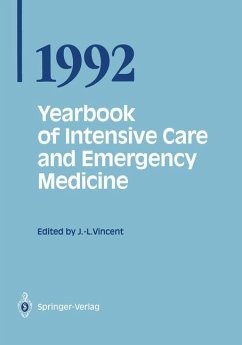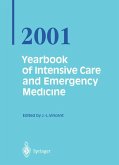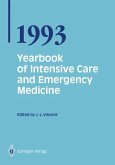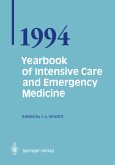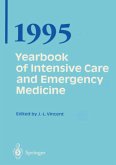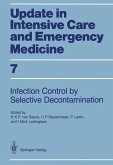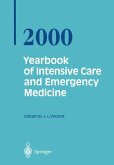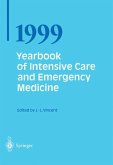Jean-Louis Vincent
Yearbook of Intensive Care and Emergency Medicine 1992
Jean-Louis Vincent
Yearbook of Intensive Care and Emergency Medicine 1992
- Broschiertes Buch
- Merkliste
- Auf die Merkliste
- Bewerten Bewerten
- Teilen
- Produkt teilen
- Produkterinnerung
- Produkterinnerung
The Yearbook 1992 continues one part of the traditionestablished by the publication of updates. The Update Seriesitself will continue with several volumes being publishedper year on topical special issues.The Yearbookcompiles the most recent, widespreaddevelopments of clinical research and practice in onecomprehensive reference book. It is addressed to everyoneinvolved in cardiology, internal medicine, anesthesia,intensive care, surgery, pediatrics and emergency medicine.
Andere Kunden interessierten sich auch für
![Yearbook of Intensive Care and Emergency Medicine 2001 Yearbook of Intensive Care and Emergency Medicine 2001]() Jean-Louis VincentYearbook of Intensive Care and Emergency Medicine 2001163,99 €
Jean-Louis VincentYearbook of Intensive Care and Emergency Medicine 2001163,99 €![Yearbook of Intensive Care and Emergency Medicine 1993 Yearbook of Intensive Care and Emergency Medicine 1993]() Jean-Louis VincentYearbook of Intensive Care and Emergency Medicine 199382,99 €
Jean-Louis VincentYearbook of Intensive Care and Emergency Medicine 199382,99 €![Yearbook of Intensive Care and Emergency Medicine 1994 Yearbook of Intensive Care and Emergency Medicine 1994]() Jean-Louis VincentYearbook of Intensive Care and Emergency Medicine 199441,99 €
Jean-Louis VincentYearbook of Intensive Care and Emergency Medicine 199441,99 €![Yearbook of Intensive Care and Emergency Medicine Yearbook of Intensive Care and Emergency Medicine]() Jean-Louis VincentYearbook of Intensive Care and Emergency Medicine42,99 €
Jean-Louis VincentYearbook of Intensive Care and Emergency Medicine42,99 €![Infection Control in Intensive Care Units by Selective Decontamination Infection Control in Intensive Care Units by Selective Decontamination]() Infection Control in Intensive Care Units by Selective Decontamination81,99 €
Infection Control in Intensive Care Units by Selective Decontamination81,99 €![Yearbook of Intensive Care and Emergency Medicine 2000 Yearbook of Intensive Care and Emergency Medicine 2000]() Prof. Jean-Louis VincentYearbook of Intensive Care and Emergency Medicine 200038,99 €
Prof. Jean-Louis VincentYearbook of Intensive Care and Emergency Medicine 200038,99 €![Yearbook of Intensive Care and Emergency Medicine 1999 Yearbook of Intensive Care and Emergency Medicine 1999]() Jean-Louis VincentYearbook of Intensive Care and Emergency Medicine 199940,99 €
Jean-Louis VincentYearbook of Intensive Care and Emergency Medicine 199940,99 €-
-
-
The Yearbook 1992 continues one part of the traditionestablished by the publication of updates. The Update Seriesitself will continue with several volumes being publishedper year on topical special issues.The Yearbookcompiles the most recent, widespreaddevelopments of clinical research and practice in onecomprehensive reference book. It is addressed to everyoneinvolved in cardiology, internal medicine, anesthesia,intensive care, surgery, pediatrics and emergency medicine.
Hinweis: Dieser Artikel kann nur an eine deutsche Lieferadresse ausgeliefert werden.
Hinweis: Dieser Artikel kann nur an eine deutsche Lieferadresse ausgeliefert werden.
Produktdetails
- Produktdetails
- Yearbook of Intensive Care and Emergency Medicine .1992
- Verlag: Springer / Springer Berlin Heidelberg / Springer, Berlin
- Artikelnr. des Verlages: 978-3-540-55241-3
- 1992.
- Seitenzahl: 728
- Erscheinungstermin: 13. März 1992
- Englisch
- Abmessung: 242mm x 170mm x 39mm
- Gewicht: 1222g
- ISBN-13: 9783540552413
- ISBN-10: 3540552413
- Artikelnr.: 26654928
- Herstellerkennzeichnung Die Herstellerinformationen sind derzeit nicht verfügbar.
- Yearbook of Intensive Care and Emergency Medicine .1992
- Verlag: Springer / Springer Berlin Heidelberg / Springer, Berlin
- Artikelnr. des Verlages: 978-3-540-55241-3
- 1992.
- Seitenzahl: 728
- Erscheinungstermin: 13. März 1992
- Englisch
- Abmessung: 242mm x 170mm x 39mm
- Gewicht: 1222g
- ISBN-13: 9783540552413
- ISBN-10: 3540552413
- Artikelnr.: 26654928
- Herstellerkennzeichnung Die Herstellerinformationen sind derzeit nicht verfügbar.
Multiple Organ Failure: A Cascade of Mediators.- Multiple Organ Failure and Infection: Cause, Consequence, or Coincidence.- The Role of the Endothelium in Multiple Organ Failure.- The Role of Interleukin-1 in Septic Shock.- Cytokines and Cytokine Antagonists in Sepsis and Critical Illness.- Tumor Necrosis Factor during Sepsis.- Interactions between TNF? and Human Polymorphonuclear Leukocytes.- Determinants of Neutrophil Adhesion Following Ischemia.- Factors Determining Endotoxin Sensitivity.- Mechanisms of Endotoxin Induced Endothelial Injury.- Novel Approaches to the Treatment of Septic Shock.- Biochemical Alterations in Ischemia and Reperfusion.- Prostanoids and Sepsis.- Cardiac Failure.- Cardiac Complications of Local Anesthetic Agents.- Perioperative Cardiac Morbidity: New Developments and Controversies.- Perioperative Heart Failure.- Phosphodiesterase Inhibitors for Treating Low-Output Syndrome.- Doppler-Echocardiography in Critically Ill Patients.- Lung Edema-Pulmonary Hemodynamics.- Acute Cardiogenic Pulmonary Edema.- The Alveolar Epithelial Barrier.- Physiological Assessment of Acute Lung Injury in the Intensive Care Unit.- Morphology of Pulmonary Vasoconstriction and Vasodilation.- Effects of Inhaled Nitric Oxide in Volunteers.- Gut Ischemia.- Pathophysiology of Gut Mucosal Barrier Breakdown in Shock.- Alterations in Gastrointestinal Barrier Function in Sepsis: The Effect of Lipopolysaccharide on Mucosal Permeability to Hydrophilic Solutes.- The Potential for Monitoring Gastric Intramucosal pH to Reduce the Costs of Critical Care.- Cellular Hypoxia.- Oxygen Delivery and Uptake: Insights from Animal Studies.- Tissue Hypoxia in Animal Models of Sepsis.- The Role of O2 Transport Related Variables in the Assessment of Tissue Oxygenation in the Clinical Setting.-Influences of Various Respiratory and Circulatory Conditions on Muscle Tissue Oxygenation in Critically Ill Patients.- Is Oxygen Consumption an Important Clinical Target?.- Respiratory Support.- Respiratory Resistances in Mechanically Ventilated Patients: The Effects of PEEP.- Assessment of Respiratory Mechanics During Total and Partial Ventilatory Support.- Synchronous and Dys-synchronous Patient-Ventilator Interactions.- Prevention of Bronchopulmonary Dysplasia by New Ventilatory Techniques.- Respiratory Failure in Asthma: Management of the Mechanically Ventilated Patient.- Approaches to Improve Survival in Severe ARDS.- The Place of Extracorporeal CO2 Removal in the Treatment of ARDS.- Difficult Weaning.- Respiratory Monitoring.- Continuous Intra-Arterial Blood Gas Monitoring.- The Expiratory Capnogram in Mechanically Ventilated Patients.- Respiratory Inductive Plethysmography for Assessing Risk of Pulmonary Barotrauma.- Evaluation of Pulmonary Mechanics in Mechanically Ventilated Children.- Infectious Complications.- General Concepts for Antimicrobial Prophylaxis in Surgery.- Intrinsic Antibiotic Resistance in Pseudomonas Aeruginosa.- Incidence and Risk Factors of ICU Acquired Pneumonia.- Pneumonia in the Intensive Care Unit: Can Critical Care Technology Help?.- Cardiopulmonary Resuscitation.- Out-of-Hospital Cardiac Arrest.- Caring for Children with Poor Outcomes from Out-of-Hospital Arrests.- Myocardial Dysfunction after Successful Cardiac Resuscitation.- Current Concepts in Brain Resuscitation.- CNS Injury and Trauma.- The Role of Free Radicals in Ischemic and Reperfusion Brain Injury.- Brain Edema and Raised Intracranial Pressure after Head Injury.- Cerebrovascular Effects of Hypertonic Resuscitation.- The 21-Aminosteroid Antioxidant Tirilazad Mesylate in CNS Injury and Hemorrhagic Shock.- Neuro-Hormonal Regulation after Trauma.- Organ Transplantation.- Acute Allograft Rejection: Immunobiology and Therapeutic Strategies.- Immunosuppression in a Critically Ill Patien.- Nutrition and Metabolism.- Enterai Nutrition for the Critically Ill.- Calcium Homeostasis during Sepsis.- Intensive Care Sedation.- Toxicology.- Major Chemical Accidents: Medical and Organizational Aspects.- Place of Activated Charcoal and Gastric Emptying in Acute Toxic Ingestions: A Critical Reappraisal.- Organization and Evaluation.- A Survey of Emergency Medical Service Systems in Europe.- Prediction of Outcome in Critically Ill Patients.- Measuring the Severity of Injury.- Decision Support Systems in Intensive Care.
Multiple Organ Failure: A Cascade of Mediators.- Multiple Organ Failure and Infection: Cause, Consequence, or Coincidence.- The Role of the Endothelium in Multiple Organ Failure.- The Role of Interleukin-1 in Septic Shock.- Cytokines and Cytokine Antagonists in Sepsis and Critical Illness.- Tumor Necrosis Factor during Sepsis.- Interactions between TNF? and Human Polymorphonuclear Leukocytes.- Determinants of Neutrophil Adhesion Following Ischemia.- Factors Determining Endotoxin Sensitivity.- Mechanisms of Endotoxin Induced Endothelial Injury.- Novel Approaches to the Treatment of Septic Shock.- Biochemical Alterations in Ischemia and Reperfusion.- Prostanoids and Sepsis.- Cardiac Failure.- Cardiac Complications of Local Anesthetic Agents.- Perioperative Cardiac Morbidity: New Developments and Controversies.- Perioperative Heart Failure.- Phosphodiesterase Inhibitors for Treating Low-Output Syndrome.- Doppler-Echocardiography in Critically Ill Patients.- Lung Edema-Pulmonary Hemodynamics.- Acute Cardiogenic Pulmonary Edema.- The Alveolar Epithelial Barrier.- Physiological Assessment of Acute Lung Injury in the Intensive Care Unit.- Morphology of Pulmonary Vasoconstriction and Vasodilation.- Effects of Inhaled Nitric Oxide in Volunteers.- Gut Ischemia.- Pathophysiology of Gut Mucosal Barrier Breakdown in Shock.- Alterations in Gastrointestinal Barrier Function in Sepsis: The Effect of Lipopolysaccharide on Mucosal Permeability to Hydrophilic Solutes.- The Potential for Monitoring Gastric Intramucosal pH to Reduce the Costs of Critical Care.- Cellular Hypoxia.- Oxygen Delivery and Uptake: Insights from Animal Studies.- Tissue Hypoxia in Animal Models of Sepsis.- The Role of O2 Transport Related Variables in the Assessment of Tissue Oxygenation in the Clinical Setting.-Influences of Various Respiratory and Circulatory Conditions on Muscle Tissue Oxygenation in Critically Ill Patients.- Is Oxygen Consumption an Important Clinical Target?.- Respiratory Support.- Respiratory Resistances in Mechanically Ventilated Patients: The Effects of PEEP.- Assessment of Respiratory Mechanics During Total and Partial Ventilatory Support.- Synchronous and Dys-synchronous Patient-Ventilator Interactions.- Prevention of Bronchopulmonary Dysplasia by New Ventilatory Techniques.- Respiratory Failure in Asthma: Management of the Mechanically Ventilated Patient.- Approaches to Improve Survival in Severe ARDS.- The Place of Extracorporeal CO2 Removal in the Treatment of ARDS.- Difficult Weaning.- Respiratory Monitoring.- Continuous Intra-Arterial Blood Gas Monitoring.- The Expiratory Capnogram in Mechanically Ventilated Patients.- Respiratory Inductive Plethysmography for Assessing Risk of Pulmonary Barotrauma.- Evaluation of Pulmonary Mechanics in Mechanically Ventilated Children.- Infectious Complications.- General Concepts for Antimicrobial Prophylaxis in Surgery.- Intrinsic Antibiotic Resistance in Pseudomonas Aeruginosa.- Incidence and Risk Factors of ICU Acquired Pneumonia.- Pneumonia in the Intensive Care Unit: Can Critical Care Technology Help?.- Cardiopulmonary Resuscitation.- Out-of-Hospital Cardiac Arrest.- Caring for Children with Poor Outcomes from Out-of-Hospital Arrests.- Myocardial Dysfunction after Successful Cardiac Resuscitation.- Current Concepts in Brain Resuscitation.- CNS Injury and Trauma.- The Role of Free Radicals in Ischemic and Reperfusion Brain Injury.- Brain Edema and Raised Intracranial Pressure after Head Injury.- Cerebrovascular Effects of Hypertonic Resuscitation.- The 21-Aminosteroid Antioxidant Tirilazad Mesylate in CNS Injury and Hemorrhagic Shock.- Neuro-Hormonal Regulation after Trauma.- Organ Transplantation.- Acute Allograft Rejection: Immunobiology and Therapeutic Strategies.- Immunosuppression in a Critically Ill Patien.- Nutrition and Metabolism.- Enterai Nutrition for the Critically Ill.- Calcium Homeostasis during Sepsis.- Intensive Care Sedation.- Toxicology.- Major Chemical Accidents: Medical and Organizational Aspects.- Place of Activated Charcoal and Gastric Emptying in Acute Toxic Ingestions: A Critical Reappraisal.- Organization and Evaluation.- A Survey of Emergency Medical Service Systems in Europe.- Prediction of Outcome in Critically Ill Patients.- Measuring the Severity of Injury.- Decision Support Systems in Intensive Care.

